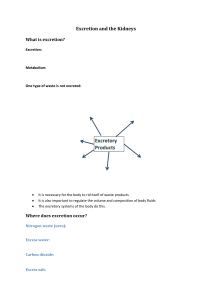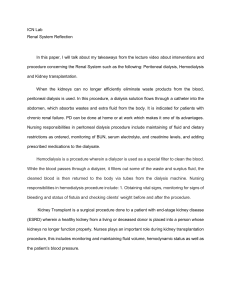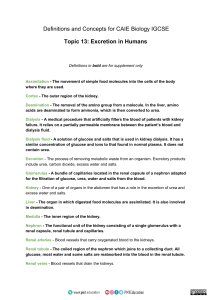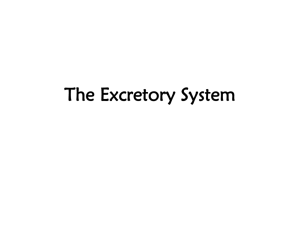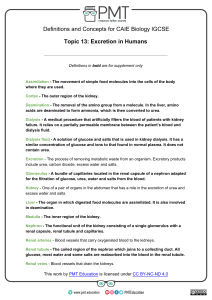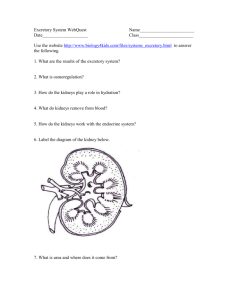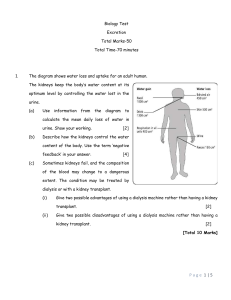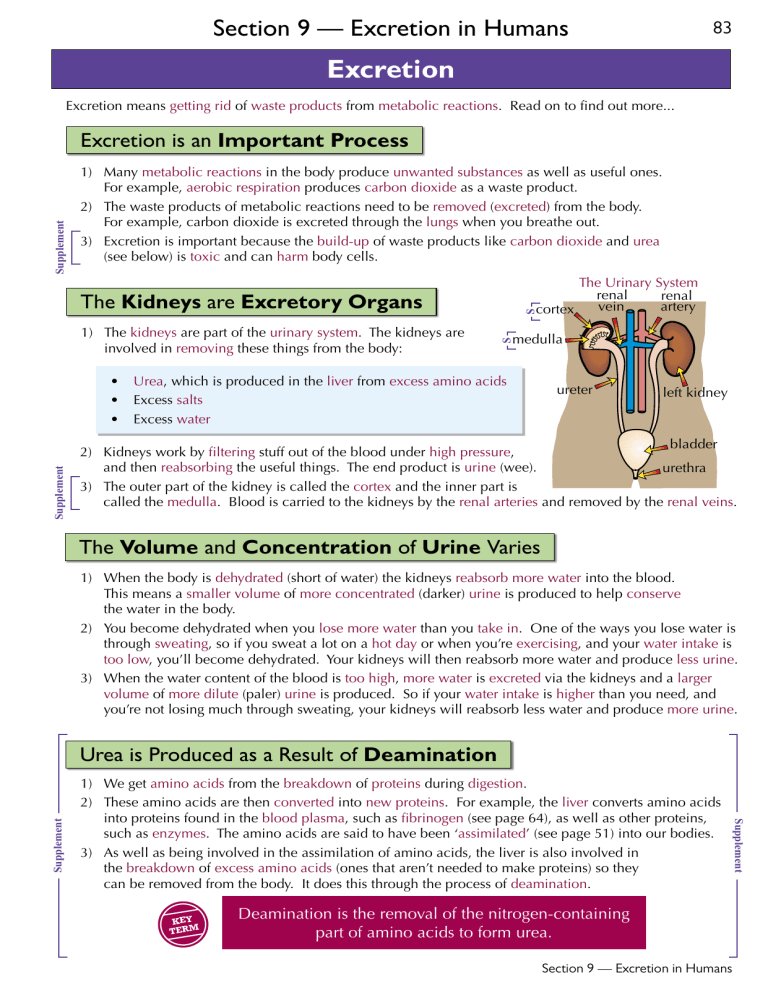
Section 9 — Excretion in Humans 83 Excretion Excretion means getting rid of waste products from metabolic reactions. Read on to find out more... Supplement Excretion is an Important Process 1) Many metabolic reactions in the body produce unwanted substances as well as useful ones. For example, aerobic respiration produces carbon dioxide as a waste product. 2) The waste products of metabolic reactions need to be removed (excreted) from the body. For example, carbon dioxide is excreted through the lungs when you breathe out. 3) Excretion is important because the build-up of waste products like carbon dioxide and urea (see below) is toxic and can harm body cells. The Urinary System renal renal artery vein cortex Supplement • • • medulla S 1) The kidneys are part of the urinary system. The kidneys are involved in removing these things from the body: S The Kidneys are Excretory Organs Urea, which is produced in the liver from excess amino acids Excess salts Excess water ureter left kidney bladder 2) Kidneys work by filtering stuff out of the blood under high pressure, and then reabsorbing the useful things. The end product is urine (wee). urethra 3) The outer part of the kidney is called the cortex and the inner part is called the medulla. Blood is carried to the kidneys by the renal arteries and removed by the renal veins. The Volume and Concentration of Urine Varies 1) When the body is dehydrated (short of water) the kidneys reabsorb more water into the blood. This means a smaller volume of more concentrated (darker) urine is produced to help conserve the water in the body. 2) You become dehydrated when you lose more water than you take in. One of the ways you lose water is through sweating, so if you sweat a lot on a hot day or when you’re exercising, and your water intake is too low, you’ll become dehydrated. Your kidneys will then reabsorb more water and produce less urine. 3) When the water content of the blood is too high, more water is excreted via the kidneys and a larger volume of more dilute (paler) urine is produced. So if your water intake is higher than you need, and you’re not losing much through sweating, your kidneys will reabsorb less water and produce more urine. 1) We get amino acids from the breakdown of proteins during digestion. 2) These amino acids are then converted into new proteins. For example, the liver converts amino acids into proteins found in the blood plasma, such as fibrinogen (see page 64), as well as other proteins, such as enzymes. The amino acids are said to have been ‘assimilated’ (see page 51) into our bodies. 3) As well as being involved in the assimilation of amino acids, the liver is also involved in the breakdown of excess amino acids (ones that aren’t needed to make proteins) so they can be removed from the body. It does this through the process of deamination. KEY TERM Deamination is the removal of the nitrogen-containing part of amino acids to form urea. Section 9 — Excretion in Humans Supplement Supplement Urea is Produced as a Result of Deamination 84 Excretion — The Kidneys Blood is filtered in the kidneys in the kidney tubules. These are positioned across the kidney cortex and medulla. Here’s what happens as blood passes through the kidney tubules... 1) Filtration: 1) Blood from the renal artery flows through the glomerulus — a bundle of capillaries at the start of the tubule (see diagram below). 2) A high pressure is built up which squeezes water, urea, salts and glucose out of the blood and into the capsule. 3) The membranes of the glomerulus act like filters, so big molecules like proteins and blood cells are not squeezed out. They stay in the blood. Filtration happens here. glomerulus blood from renal artery capillary network Reabsorption happens here, as does water regulation. blood to vein capsule Supplement tubule collecting duct KEY: = blood = fluid in tubule = reabsorption = filtration | | | | | || 2) Reabsorption: It’s called selective reabsorption because only some substances are reabsorbed. urine || | | | | | || | | | | | | | | | | | | | | | | | | | | | | | | | | | | | | | | | Release of wastes. || | | | | | | | | | | | | | | | | | | | | | | | | | | | | | | | | | | As the fluid flows along the tubule, useful substances are selectively reabsorbed back into the blood: 1) All the glucose is reabsorbed so that it can be used in respiration. The reabsorption of glucose involves the process of active transport (see p.24) against the concentration gradient. 2) Some salts are reabsorbed. Excess salts aren’t. 3) Most water is reabsorbed. This happens by osmosis (see p.21) and leads to urea becoming more concentrated in the fluid. 3) Release of Wastes: The remaining substances (including excess water, excess salts and urea) form urine. This continues out of the tubule, through the ureter and down to the bladder, where it is stored before being released via the urethra. The kidneys remove urea and control salt and water levels Remember the three subheadings on this page — they’re key to understanding how the kidneys work. Section 9 — Excretion in Humans Supplement from another tubule 85 Treatments for Kidney Failure If someone’s kidneys stop working, there are two treatments — dialysis or a transplant. | | | | | || Dialysis Machines Filter the Blood Dialysis machines are sometimes called kidney machines. | | | | | | | || | | | | | | | | | | | | | | | | | | | | | | | | | | | | || | | | | | | | | | | | | | | | | | | | | | | | | | | || 1) People with kidney failure have to have dialysis done regularly to keep the concentrations of dissolved substances in the blood at normal levels, and to remove waste substances. 2) In a dialysis machine the person’s blood flows between partially permeable membranes, surrounded by dialysis fluid. The membranes are permeable to things like salts and waste substances, but not big molecules like proteins (just like the membranes in the kidney). 3) The dialysis fluid has the same concentration of salts and glucose as healthy blood. partially permeable membrane dialysis fluid out 4) This means that the glucose concentration and salt balance of the blood will be maintained because useful salts and glucose won’t be lost from the blood during dialysis. | | | | | | | | || || | | from person back to person 5) Only waste substances (such as urea), excess salts and excess water diffuse across the barrier. 6) Many patients with kidney failure have to have a dialysis session three times a week. Each session takes 3-4 hours, so dialysis takes up a lot of time. 7) Plus, dialysis may cause blood clots or infections. 8) Being on a dialysis machine is not a pleasant experience and it is expensive for the NHS to run. 9) However, dialysis can buy a patient with kidney failure time until a donor organ is found. Supplement Supplement waste products diffuse out into dialysis fluid | | | | | | | | | | | | | | | || || | | | | | | | | dialysis fluid in Glucose and salts won’t be lost because their concentration inside and outside of the blood is the same, so there is no concentration gradient. | | | | | | | | | || | | | | | | | | | | | | | | | | | | | || | | | | | | | | | Kidney Transplants are a Cure, but can be Rejected 1) At the moment, the only cure for kidney failure is to have a kidney transplant. 2) Healthy kidneys are usually transplanted from people who have died suddenly. 3) Kidneys can also be transplanted from people who are still alive (as we all have two of them) but there is a small risk to the person donating the kidney. 4) Whoever the donor kidney comes from, there is a risk that the donor kidney will be rejected by the patient’s immune system. Two things can be done to try to reduce the risk of this happening: • The patient is treated with drugs to suppress their immune system. They must take these drugs for the rest of their life. • Donor kidneys are matched by blood type (and a few other things) to the patient — however, this means a potentially long waiting time for a suitable kidney. 5) Despite these drawbacks, transplants are cheaper (in the long run) than dialysis and they can put an end to the hours patients have to spend on dialysis. ION RE V I S TIP Dialysis or transplant? Both have their downsides... You need to be able to write about the advantages and disadvantages of kidney transplants in comparison with dialysis. Draw yourself a table with ‘Advantages’ in the header for one column, and ‘Disadvantages’ in the other. Then cover up the page and try to fill in the table from memory. Section 9 — Excretion in Humans 86 & Exam Questions CtrlWarm-Up + Shift Select to bring onto page Think you know everything there is to know about excretion in humans? Time to put it to the test... S Warm-Up Questions 1) 2) 3) 4) 5) Where is urea produced? Through which organ is the waste product carbon dioxide excreted? What is deamination? What is the glomerulus? Why is excretion of carbon dioxide necessary? Exam Questions 1 A runner went for a 10 mile run on a warm day. When she got home she noticed that her urine was darker in colour than normal. Explain why the runner produced darker coloured urine. [Total 4 marks] 2 The substances below are all present in the blood before it passes through a glomerulus. Which of these substances are present in the fluid at the start of a kidney tubule? 1. glucose 2. urea 3. proteins 4. water A 1 and 2 B 1, 2 and 3 C 1, 2 and 4 D 1, 2, 3 and 4 3 Supplement Supplement [Total 1 mark] A hospital patient has kidney failure. She has dialysis three times a week. (a) Explain how the dialysis machine removes urea from the patient’s blood. [2] (b) Explain why the patient does not lose glucose from her blood during dialysis. [2] The patient is on the waiting list to receive a kidney transplant. (c) Suggest one reason why this form of treatment may be preferable to dialysis. [1] (d) Give one disadvantage of kidney transplants. [1] [Total 6 marks] Section 9 — Excretion in Humans Sample question The liver and its role in dealing with excess amino acids Surplus amino acids in the bloodstream cannot be stored. They are removed by the liver and some are assimilated by converting them into proteins. Examples of these include plasma proteins (e.g. fibrinogen in the blood; see Chapter 9). The surplus amino acids are broken down into urea (which is the nitrogen-containing part of the amino acid) and a sugar residue (which can be respired to release energy). The breakdown of amino acids is called deamination. Urea is returned to the bloodstream (into the hepatic vein) and filtered out when it reaches the kidneys. Exam-style questions 1 Figure 13.4 shows the water balance of the body. The term metabolism refers to chemical processes in cells. water gains water losses a One of the components of water loss is urine. State two chemicals dissolved in water in urine. [2] faeces b i Calculate the volume of urine lost, 100 cm3 based on the data shown. [2] metabolism 400 cm3 sweat 400 cm3 ii What percentage of water lost is breathing urine? [2] food 500 cm3 400 cm3 drinking 1500 cm3 urine X cm3 Figure 13.4 2 Figure 13.5 shows the human urinary system. a Name parts X, Y and Z. b Name the blood vessel that carries blood from the aorta to the kidneys. c Suggest two differences between the composition of the blood flowing to the kidneys and the blood flowing away from the kidneys. aorta [3] [1] X [2] Y Z Figure 13.5 It is illegal to photocopy this page 3 Copy and complete the passage about the function of the kidney, using the words provided. Each word may be used once, more than once, or not at all. artery glucose ureter vein capillaries mineral ions urethra water glomeruli renal capsule urine Blood passes into the kidney from the renal called . Reabsorption of . The blood is filtered by millions of tangled and occurs first in the tubule. are absorbed further down the tubule. The remaining filtrate is called to the bladder for storage. 82 Cambridge IGCSE Biology Study and Revision Guide Third Edition . This passes down the [8] IGCSE files&documents telegram channel Join now:https://t.me/igcse_files IGCSE files&documents telegram channel Join now:https://t.me/igcse_files IGCSE files&documents telegram channel Join now:https://t.me/igcse_files IGCSE files&documents telegram channel Join now:https://t.me/igcse_files 12 Excretion + deamination the removal of the nitrogen-containing part of amino acids to form urea Exercise 12.1 The human excretory system Try to answer these questions from memory, without looking anything up. This will be a good test of your knowledge and understanding of the structure and function of the human excretory system. The diagram shows the human excretory system. a Label these structures on the diagram. aorta renal vein IGCSE Biology bladder vena cava kidney urethra renal artery ureter b On the diagram, draw arrows in each of these structures to show the direction in which the liquids inside them flow: renal artery renal vein urethra ureter C Describe three ways in which the liquid contained in the ureter differs from the liquid contained in the renal artery. 12 Excretion 0 Exercise 12.2 Dialysis In this exercise, you will use your knowledge and understanding of diffusion to work out the answers to questions (A02). If a person's kidneys fail, they may be able to use a kidney dialysis machine to carry out the roles normally done by the kidneys. The diagram shows how kidney dialysis can be carried out. fresh dialysis fluid in dialysis machine t blood returned to the body blood pressure monitor blood returned to vein blood pump from vein a Suggest why the blood is withdrawn from a vein, rather than from an artery. b Suggest why the blood flows through many small channels in the dialysis unit, rather than through a single large channel. IGCSE Biology 0 The table shows the concentrations of some of the substances in dialysis fluid and in a person's blood plasma before it enters the dialysis unit. Substance Concentration in dialysis fluid I mmol per dm3 Concentration in blood plasma /mmol per dm 3 glucose 5 5 protein 0 8 urea 0 7 Use the information in the table, and your knowledge of how dialysis takes place, to answer the following questions. C What will happen to the concentration of glucose in the person's blood as it passes through the dialysis unit? Explain your answer. d What will happen to the concentration of protein in the person's blood as it passes through the dialysis unit? Explain your answer. e What will happen to the concentration of urea in the person's blood as it passes through the dialysis unit? Explain your answer. 12 Excretion 13 Excretion in humans Core 1 When urea is excreted, it passes through a number of structures before it is released as urine. Put the structures in the correct order, starting with the aorta. bladder capillary kidney renal artery ureter urethra aorta Supplement 2 Complete the paragraph about the function of the kidney, using words from the list. active uptake excreted blood less osmosis reabsorbed more The kidney filters concentrated diffusion dilute water , removing urea, excess and some ions. is also filtered out, but it is all All the glucose . Some water is also reabsorbed, depending on the state of hydration of the body. On a hot day water is reabsorbed, resulting in a small amount of urine. Water is reabsorbed , while glucose and ions are returned to the blood by by the process of and . 3 a Describe how the level of amino acids is controlled in the body, making three key points. b State two functions of the liver, other than the control of amino acid levels. 1 2 Cambridge IGCSE™ Biology Workbook Third Edition Photocopying prohibited 51 13 EXCRETION IN HUMANS 4 The diagram shows a section through a kidney. a i Identify the labelled parts. V W X V X W Y ii State which of the parts you have named: contains the glomeruli Y transfers urine to the bladder. b Outline the roles of the following parts of the kidney, making two key points for each: i glomerulus ii nephron iii collecting duct. Exam-style questions to the heart Core Y 1 The diagram shows the urinary system. a i On the diagram, label parts A–E. ii State three ways in which the substances in solution in part A would be different from those in part C. [5] X A ............................................................................ B ............................................................................ C ............................................................................ D ............................................................................ E ............................................................................ 1 2 3 [3] iii Suggest how the contents of part D would be different on a hot day compared to a cold day. [2] 52 Photocopying prohibited Cambridge IGCSE™ Biology Workbook Third Edition 13 Excretion in humans b State three differences between the structure of blood vessels X and Y. 1 2 3 [3] [Total: 13] Supplement 2 a Outline the structure and function of a nephron and its associated blood vessels. [6] b Explain why the kidney is an important organ in the body. [3] [Total: 9] 3 a State how amino acids travel from the small intestine to the liver. [2] b Describe how the liver assimilates amino acids. [1] c Outline the process of deamination. [2] [Total: 5] Cambridge IGCSE™ Biology Workbook Third Edition Photocopying prohibited 53
